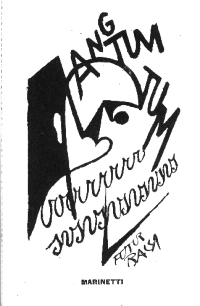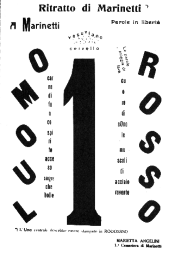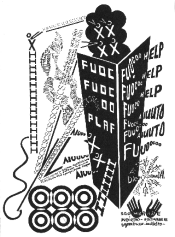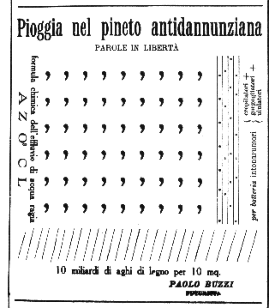Italian Futurism
 Giacomo Balla,
Marinetti (1925)
Giacomo Balla,
Marinetti (1925)
Italian Futurism was initially a literary
movement created by Filippo Tommaso Marinetti in 1909 with the manifesto Le
Futurisme [1]. The intentions of this manifesto
was a wake-up call to Marinetti's countrymen to make them aware that they had
been 'wearing second-hand clothes for too long.' It was time for them to create
a new art for themselves, forged out of the beauty of speed and a glorification
of war: Art, in fact, can be nothing but violence, cruelty, and
injustice. That the manifesto was first written in French and published in
the Parisian newspaper Le Figaro before any of the new Futurist art
existed, typified Marinetti's understanding of the power of the media to work
for him and disseminate his ideas.
M. Angelini, Ritratto di
Marinetti (1916)

F. T. Marinetti along with the artists that
he gathered around him, wrote manifestos not only on literature, music, dance,
performance, painting, architecture, etc. but also on almost all aspects
touching everyday life, such as clothing, food [2],
smells, war and lust [3]. Futurism was the first
attempt in the 20th century to reinvent life as it was being transfixed by new
technologies and conceive of a new race in the form of machine-extended man.
Futurism succinctly reiterated a cognate set of ideas which reverberates all
through a multitude of forms in 20th century art expression.
These were ideas which were already in
the air, many filtering up through the Symbolist and Expressionistic poets of
the 19th century. The impact of radically new forms of
technology had made profound effects upon Western culture, and these too
were at the core of the Futurist enterprise. From the collapse and bankruptcy
of traditional Western art forms and aesthetics at the end of 19th century, the
art of discontinuity and rupture was produced [4].
Fortunato Depero,
Incendio (1929)

. The Italians were among the first to
identify and place their own claims upon these new ways of perceiving and
acting. Marinetti took a group of Italian painters to Paris to show them how
they should be painting and particularly expose them to Cubism
[5]. He also used his quite sophisticated skills as
the 'caffeine of Europe' to manipulate the media and proselytize Futurism all
over the world. However, his actual appearance in the local neighborhoods of
artists spawned as much violent reaction (such as the Vorticism movement of
Pound and Lewis) as it did influence. In Russia, the development of the local
cubo-futurism movement was associated to Marinetti's
efforts largely through a quirk in translation. When the members of the
movement finally did meet Marinetti, they ended up distancing themselves as far
as possible from Marinetti's ideas of art as technological warfare. Many other
manifestations and reactions to Futurism sprang up throughout the world during
the early part of the century in Hungary, Poland, Ukraine, Holland, Portugal,
America (particularly synchronistic art and the poetry of Hart Crane), as well
as other places.
Futurist literary theory[6] was intent upon increasing the expressivity of
language. A Futurist poet would project words from the page like a machine gun
firing bullets. This they did with a variety of techniques both visually and
sonically. They were especially interested in those methods which would blur
the borderline between the dimensions to create a synesthesia: by evoking all
of the senses, the work would have a more profound impact.
 Paolo Buzzi, parole
in liberta (1916)
Paolo Buzzi, parole
in liberta (1916)
The mots in liberta poetry of Italian
Futurism contained no adjectives, adverbs, finite verbs, punctuation --
anything that would slow it down. It was mostly a collage of nouns, and this
form of their poetry was intended to be an uninterrupted sequence of new
images. Their parole in liberta poetry functioned on a level below
mots in liberta, at what the Futurists believed to be the basis of all
language: onomatopoeia. This they defined in their technical manifestos of
consisting of four basic types: realistic, analogical, abstract (the 'sound of
a state of mind'), and psychic harmony (the fusion of two or three of the
abstract representations).
Though strictly speaking, parole in
liberta is not sound poetry, this fourth type of onomatopoeia approached
the kind of phonetic poetry that the later Dadaist would develop. In keeping
with Futurist doctrines of returning to the senses, parole in liberta
also explored noise as the primal source of their onomatopoeia-rooted
linguistics. This had a big influence on the Italian Futurist painter, Luigi
Russolo, who in turn invented an Art of Noise, which
then had an extensive impact on succeeding generations, resulting in Russolo
being viewed as the 'grandfather' of modern sound culture.
Performances of Futurist poetry were
meant to outrage and wake up an audience, in a time when poetry had largely
become a plaything of the idle rich. Poetry was often presented in the late
nineteenth century cultured drawing rooms with wine, caviar, and a bought
romantic poet with slicked-back hair: doing his best to capture the poetic
affectations of the times and pretending to be an Oscar Wilde clone, complete
with a dead lily. The Futurists on the other hand, acting as if they were the
Vikings or Hell's Angels of Art, were intent in trashing such cultivated and
stylized aesthetics completely. Their performances often ended in riots with
several members of the audience in the hospital and several Futurists ending up
in jail [7].
References and Notes:
1. An English translation of
Fondazione e Manifesto del futurismo (the 'Founding and Manifesto of
Futurism'), as well as a selection of Marinetti's other writings can be found
in Let's Murder the Moonshine: Selected Writings, translated by R. W. Flint and
Arthur A. Coppotelli (Los Angeles: Sun & Moon Classics, 1991).
2. F. T. Marinetti, The Futurist
Cookbook, translated by Suzanne Brill, edited with an introduction by
Lesley Chamberlain (San Francisco: Bedford Arts. 1989).
3. A brief summary of the many areas
which Futurism attempted to redefine can be found in Futurism, by
Caroline Tisdall and Angelo Bozzolla (London: Oxford University Press, 1978).
4. That Futurism existed as a
movement and a cognate set of ideas common to many radical artists at the
beginning of this century, is explored by Marjorie Perloff in The Futurist
Moment: Avant-Garde, Avant Guerre, and the Language of Rupture (Chicago:
The University of Chicago Press, 1986).
5. The term Cubism was invented around
1906 and 1908 by the painter Henri Mattisse and the poet Guillaume Apollinaire.
The chief aspect which soon became apparent with Cubism as well as Futurism was
the use of collage. The 'invention' of collage was either of Cubist or Futurist
origins: Apollinaire was certainly involved as well as the Italian painter,
Gino Severini. Collage is probably the single most important and innovative
manipulatory technique in the 20th century. It is perhaps the artistic answer
to the graphic layout of the modern newspaper, which had radically changed in
the later part of the 19th century due to technological innovations in
typesetting and increased literacy among the masses.
6. An extensive analysis of this
subject can be found in John J. Whites's Literary Futurism: Aspects of the
First Avant-Garde (New York: Oxford University Press, 1990).
7. Michael Kirby, Futurist
Performance, with manifestos and playscripts translated from the Italian by
Victoria Nes Kirby (New York: E. P. Dutton & Co., Inc., 1971).
Images are from 12-Parolibere Futuriste-12 (Firenze:Libreria
Salimbeni Firenze, nd.).
Last Modified 28 September 1999
 Giacomo Balla,
Marinetti (1925)
Giacomo Balla,
Marinetti (1925) 

 Paolo Buzzi, parole
in liberta (1916)
Paolo Buzzi, parole
in liberta (1916)